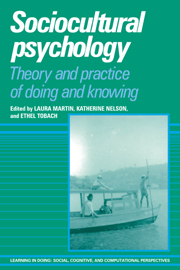Book contents
- Frontmatter
- Contents
- Series foreword
- Preface
- Contributors
- 1 Introduction
- Part I History and culture
- Part II Doing psychology
- 5 Opening vistas for cognitive psychology
- 6 Analysis of developmental processes in sociocultural activity
- 7 Linking thought and setting in the study of workplace learning
- 8 Cultural–historical psychology: A meso-genetic approach
- 9 The abstract and the concrete
- 10 From spontaneous to scientific concepts: Continuities and discontinuities from childhood to adulthood
- 11 The psychology of Japanese literacy: Expanding “the practice account”
- 12 Voices of thinking and speaking
- Part IV Activity in work and school
- Index
10 - From spontaneous to scientific concepts: Continuities and discontinuities from childhood to adulthood
Published online by Cambridge University Press: 05 November 2011
- Frontmatter
- Contents
- Series foreword
- Preface
- Contributors
- 1 Introduction
- Part I History and culture
- Part II Doing psychology
- 5 Opening vistas for cognitive psychology
- 6 Analysis of developmental processes in sociocultural activity
- 7 Linking thought and setting in the study of workplace learning
- 8 Cultural–historical psychology: A meso-genetic approach
- 9 The abstract and the concrete
- 10 From spontaneous to scientific concepts: Continuities and discontinuities from childhood to adulthood
- 11 The psychology of Japanese literacy: Expanding “the practice account”
- 12 Voices of thinking and speaking
- Part IV Activity in work and school
- Index
Summary
Conceptual change, a topic of considerable current interest in both developmental and general cognitive psychology, is important to issues in education, knowledge organization, and cognitive development. In this chapter Vygotsky's (1934/1986) ideas about the shift from “spontaneous” to “scientific” concepts are considered in the context of a longstanding issue of conceptual change – the establishment of hierarchical inclusive taxonomic structures in early to mid-childhood – and are related to other specific proposals and problems that have been raised in the recent literature with respect to both developmental change in childhood and conceptual change throughout the lifespan.
Spontaneous and scientific concepts
The problem of conceptual change in childhood from spontaneous to scientific concepts was a central topic of Vygotsky's Thought and Language. He hypothesized “two different paths in the development of two different forms of reasoning.” In scientific thinking “the primary role is played by initial verbal definition, which being applied systematically, gradually comes down to concrete phenomena.” In contrast, “the development of spontaneous concepts knows no systematicity and goes from the phenomena upward toward generalization” (Vygotsky 1986, p. 148). In this description his concern was less with scientific thinking than with the acquisition of scientific concepts, very broadly conceived, in contrast to spontaneous concepts formulated by the individual child. Note especially here that Vygotsky assumed that spontaneous concepts were not systematically organized. His idea of systematicity (to be explicated in later sections) rested primarily on the establishment of hierarchical taxonomies.
As implied in the statement just quoted, the difference between spontaneous and scientific concepts for Vygotsky was an important aspect of the language-thought relation.
- Type
- Chapter
- Information
- Sociocultural PsychologyTheory and Practice of Doing and Knowing, pp. 229 - 249Publisher: Cambridge University PressPrint publication year: 1995
- 4
- Cited by



